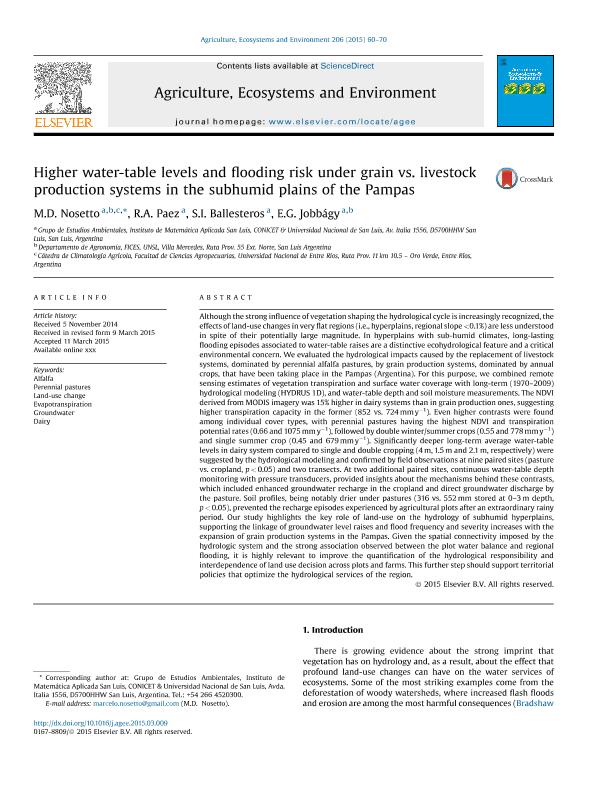Mostrar el registro sencillo del ítem
dc.contributor.author
Nosetto, Marcelo Daniel

dc.contributor.author
Paez, Ricardo Andrés

dc.contributor.author
Ballesteros, Silvina

dc.contributor.author
Jobbagy Gampel, Esteban Gabriel

dc.date.available
2020-09-23T14:20:55Z
dc.date.issued
2015-08
dc.identifier.citation
Nosetto, Marcelo Daniel; Paez, Ricardo Andrés; Ballesteros, Silvina; Jobbagy Gampel, Esteban Gabriel; Higher water-table levels and flooding risk under grain vs. livestock production systems in the subhumid plains of the Pampas; Elsevier Science; Agriculture, Ecosystems and Environment; 206; 8-2015; 60-70
dc.identifier.issn
0167-8809
dc.identifier.uri
http://hdl.handle.net/11336/114612
dc.description.abstract
Although the strong influence of vegetation shaping the hydrological cycle is increasingly recognized, the effects of land-use changes in very flat regions (i.e. hyperplains, regional slope <0.1%) are less understood in spite of their potentially large magnitude. In hyperplains with sub-humid climates, long-lasting flooding episodes associated to water-table raises are a distinctive ecohydrological feature and a critical environmental concern. We evaluated the hydrological impacts caused by the replacement of livestock systems, dominated by perennial alfalfa pastures, by grain production systems, dominated by annual crops, that has been taking place in the Pampas (Argentina). For this purpose, we combined remote sensing estimates of vegetation transpiration and surface water coverage with long-term (1970-2009) hydrological modeling (HYDRUS 1D), and water-table depth and soil moisture measurements. The NDVI derived from MODIS imagery was 15% higher in dairy systems than in grain production ones, suggesting higher transpiration capacity in the former (852 vs. 724 mm y^-1). Even higher contrasts were found among individual cover types, with perennial pastures having the highest NDVI and transpiration potential rates (0.66 and 1075 mm y^-1), followed by double winter/summer crops (0.55 and 778 mm y^-1) and single summer crop (0.45 and 679 mm y^-1). Significantly deeper long-term average water-table levels in dairy system compared to single and double cropping (4 m, 1.5 m and 2.1 m, respectively) were suggested by the hydrological modeling and confirmed by field observations at nine paired sites (pasture vs. cropland, p<0.05) and two transects. At two additional paired sites, continuous water-table depth monitoring with pressure transducers, provided insights about the mechanisms behind these contrasts, which included enhanced groundwater recharge in the cropland and direct groundwater discharge by the pasture. Soil profiles, being notably drier under pastures (316 vs. 552 mm stored at 0-3 m depth, p< 0.05), prevented the recharge episodes experienced by agricultural plots after an extraordinary rainy period. Our study highlights the key role of land-use on the hydrology of subhumid hyperplains, supporting the linkage of groundwater level raises and flood frequency and severity increases with the expansion of grain production systems in the Pampas. Given the spatial connectivity imposed by the hydrologic system and the strong association observed between the plot water balance and regional flooding, it is highly relevant to improve the quantification of the hydrological responsibility and interdependence of land use decision across plots and farms. This further step should support territorial policies that optimize the hydrological services of the region.
dc.format
application/pdf
dc.language.iso
eng
dc.publisher
Elsevier Science

dc.rights
info:eu-repo/semantics/openAccess
dc.rights.uri
https://creativecommons.org/licenses/by-nc-sa/2.5/ar/
dc.subject
ALFALFA
dc.subject
PERENNIAL PASTURES
dc.subject
LAND-USE CHANGE
dc.subject
EVAPOTRANSPIRATION
dc.subject
GROUNDWATER
dc.subject
DAIRY
dc.subject.classification
Agricultura

dc.subject.classification
Agricultura, Silvicultura y Pesca

dc.subject.classification
CIENCIAS AGRÍCOLAS

dc.title
Higher water-table levels and flooding risk under grain vs. livestock production systems in the subhumid plains of the Pampas
dc.type
info:eu-repo/semantics/article
dc.type
info:ar-repo/semantics/artículo
dc.type
info:eu-repo/semantics/publishedVersion
dc.date.updated
2020-09-01T19:10:35Z
dc.journal.volume
206
dc.journal.pagination
60-70
dc.journal.pais
Países Bajos

dc.journal.ciudad
Amsterdam
dc.description.fil
Fil: Nosetto, Marcelo Daniel. Consejo Nacional de Investigaciones Científicas y Técnicas. Centro Científico Tecnológico Conicet - San Luis. Instituto de Matemática Aplicada de San Luis "Prof. Ezio Marchi". Universidad Nacional de San Luis. Facultad de Ciencias Físico, Matemáticas y Naturales. Instituto de Matemática Aplicada de San Luis "Prof. Ezio Marchi"; Argentina. Universidad Nacional de Entre Ríos. Facultad de Ciencias Agropecuarias; Argentina
dc.description.fil
Fil: Paez, Ricardo Andrés. Consejo Nacional de Investigaciones Científicas y Técnicas. Centro Científico Tecnológico Conicet - San Luis. Instituto de Matemática Aplicada de San Luis "Prof. Ezio Marchi". Universidad Nacional de San Luis. Facultad de Ciencias Físico, Matemáticas y Naturales. Instituto de Matemática Aplicada de San Luis "Prof. Ezio Marchi"; Argentina
dc.description.fil
Fil: Ballesteros, Silvina. Consejo Nacional de Investigaciones Científicas y Técnicas. Centro Científico Tecnológico Conicet - San Luis. Instituto de Matemática Aplicada de San Luis "Prof. Ezio Marchi". Universidad Nacional de San Luis. Facultad de Ciencias Físico, Matemáticas y Naturales. Instituto de Matemática Aplicada de San Luis "Prof. Ezio Marchi"; Argentina
dc.description.fil
Fil: Jobbagy Gampel, Esteban Gabriel. Consejo Nacional de Investigaciones Científicas y Técnicas. Centro Científico Tecnológico Conicet - San Luis. Instituto de Matemática Aplicada de San Luis "Prof. Ezio Marchi". Universidad Nacional de San Luis. Facultad de Ciencias Físico, Matemáticas y Naturales. Instituto de Matemática Aplicada de San Luis "Prof. Ezio Marchi"; Argentina
dc.journal.title
Agriculture, Ecosystems and Environment

dc.relation.alternativeid
info:eu-repo/semantics/altIdentifier/url/http://www.sciencedirect.com/science/article/pii/S0167880915000936
dc.relation.alternativeid
info:eu-repo/semantics/altIdentifier/doi/https://doi.org/10.1016/j.agee.2015.03.009
Archivos asociados
